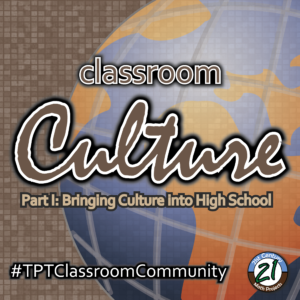There’s much to learn from 2016. Today, it is clear we may be in for a turbulent few months and this will seep into the classroom. As a solution to this, TeachersPayTeachers has started an initiative #TPTClassroomCommunity. The aim is to cultivate resources and house conversation around classroom issues like Character Education. They’ve created a new category for such resources.

While, I’ve worked K-12 in all levels of a school building, for this post I will focus on ways to celebrate culture in high schools. This will be Part 1 in a #TPTClassroomCommunity series. I do not speak definitively, I only offer ideas and suggestions for your own reflection.
Outside of a structure like a school-wide advisory program, where exactly character education and diversity issues fit is a bit tricky. Perhaps an ELA or Social Studies class can bring in Social Justice issues, but the reality is in high school it is more difficult to carve out the time. I think culture can be infused into any class, any subject, but there are a few things that need to be done before we get there.
1.) Let’s learn before we teach
You earned a degree and a subject area license to share the topic that you teach. You had to learn all this stuff. Now while sharing culture doesn’t require post-graduate study, it would be ignorant to think that it can just happen. Before culture and global issues can brought into the classroom, there has to be learning. And it starts with you. You have the power.
I know many teachers are out of their comfort zone reaching out into the real world. They feel they aren’t capable, they assume others will do this, it takes more time. So here’s the secret — you are capable, others likely will not do this, and, yes, it does take more time — but —
— it’s worth it for your kids AND it’s worth it for you. Some kids walk out of their comfort zones every day. You can too.This is a case where professional development is personal development.
2.) Experiential learning
As a teacher, if the most diverse place that you spend time is your own classroom, then are you best positioning yourself to push it forward? I argue the answer is likely no.
I’ve seen many new teachers struggle with the transition of working in minority-majority classrooms. And not necessarily just white teachers. Most teachers get into teaching because they liked school. They probably liked their teachers. They probably took more challenging classes with engaged, focused learners. And then the issue — they probably think that their classroom should look and feel like it did when they were a student. When 90% of your day doesn’t — because it doesn’t — what is the response? An authoritarian discipline policy? A patronizing sarcasm? Getting ran over and lose classroom control?
OR —
— figuring out how to best position yourself to push your classroom forward.
Let me be clear, ANY high school classroom ANYwhere can look like this. However, there is an additional dynamic when working in a minority-majority classroom (which is also often unlike the classroom most young teachers grew up in). Let’s not forget many young teachers are 23,24,25 years old. From high school to college to the classroom — how much diversity have they encountered along the way? It varies. I’ve been involved in a few situations with young teachers (and WAY too many substitute teachers), that when things start to escalate, things can get “kinda racist”. Often out of ignorance.
Supporting a teacher and not undermining their classroom authority, but not disenfranchising the voice of a kid that believes things they heard were racist (because they kinda were) #principalproblems
Here’s the solution —
— experience. And this isn’t just on the job. And I think it’s beyond just being nice to “all” people. This means visiting ethnic grocery stores, traveling, volunteering in the communities you teach (especially before you teach there), visiting religious institutions… that sort of thing.
The most popular PD I ever gave my teachers was a day I gave them a list of places they could go visit — I themed it after Amazing Race. I had people at the locations ready to greet them and educate them. A mosque, a Unitarian Church, a soup kitchen, a Black Arts academy, a food bank among other places. They could go anywhere and as a team build out a hypothetical project to benefit the organization they were visiting.
Teachers could earn bonus points for other cultural challenges (like visiting an ethnic grocery store).
But this was just ONE day. If you want experience, it happens over time. However should you desire to become educated about something or a community the best solution is engaging in it. All of the organizations, I sent teachers had regular times that they welcomed the public for information sessions.
3.) Issues
How can you bring more of the world into the classroom, if you aren’t educating yourself about global issues?
Reading is good. Often culture is intertwined in global issues. If you read the day’s news, perhaps even bring Current Events into your classroom, you’ll realize your vocabulary, fluency and competency is increasing. Hey, that’s what learning is!
For some, I think approaching this topic through global issues may feel “safer”, but still a high quality entry point. Culture may lead to missteps that may be offensive. Global issues are global issues. As your fluency increases, you’ll realize you are better able to get cross curricular and turn that proportion math assignment into a project into microlending or conflict minerals. Or at least more comfortable using things like that you may find on TPT.
4.) Effectively nip pre-bullying
To most effectively celebrate culture, you’ll have to be an effective nipper of pre-bullying. A lot bullying doesn’t start malicious. It slowly builds. Often in the early stages it is misunderstanding and at times ignorance. If this ignorance goes unchecked, it becomes a thing. Ignorance just means a young person needs to learn something. Who will teach them? You.
If you’ve worked through #1,#2 and #3 you are best positioning yourself to work through these sort of things.
Why? Because you’ll be more in tune to notice it. You’ll be able to articulate more comfortably. And young people WILL listen to you when you speak life.
If a comment spits out and it’s ignorant or kind of offensive. Deflecting it away with truth and the heart of a teacher is effective. If a comment spits out between two students that you sense is off. Keeping them after class for a minute to work and teach through it is effective.
A complication — many minorities seek desperately to assimilate. They don’t want to feel like they are the victim of something offensive. So just because a student says something doesn’t bother them, it doesn’t mean that conversation with the offender doesn’t need to happen. Just take a different angle, “I know what you said would bother many… and I just want you to understand… ” Generally, kids are awkward, but appreciate this if you deliver the message effectively.
—-
This is not an overnight job. This is a dedication to your kids, the communities you serve and yourself.


